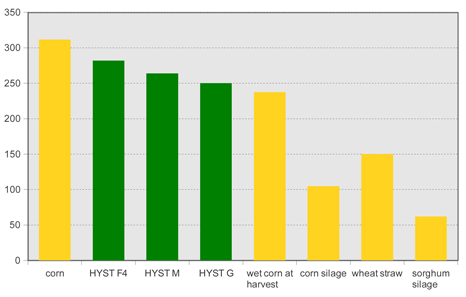Results
Hyst technology has achieved important results in enhancing the use of cereal straw for the production of biogas /biomethane. This technology’s low cost pre-treatment processes can free cellulose from the grip of lignin and make it even more available for subsequent conversion into biofuels.
ENEA, through Dr. Vito Pignatelli, Coordinator of Technologies, Biomass and Bioenergies, has already expressed interest in this technology (AGI May 31 2010). Dr. Pignatelli himself cited Hyst technology as an example of cutting-edge Italian technology in the field of biogas/biomethane.
Biomethanation of material processed in Hyst machines indicate how the use of straw in digesters is not only possible but also profitable. Straw flours (denominated G, M and F4) generated from Hyst processing have an extremely high production capacity and about double that of the raw material (Table 1).

Table 1: Production of methane in mesophilic conditions from matrices produced with Hyst systems using cereal straw, compared with typical values of straw not subjected to pre-treatment (processing produces 3 matrices, denominated G, M and F4).
*Source: Sharma et al. 1988

Figure 1: Biomethane production (m3/t w.b.) of HYST matrices from cereal straw compared with production of other biomass.
Hyst straw flours (150-600 μm) can easily be mixed with digester sludge, thus optimizing the digestion process: straw generally tends to float on the sludge and does not degrade satisfactorily. Moreover, Hyst treatment is able to modify the structure of the substrate, as evidenced by the variation of the C/N ratio of the products compared to characteristic value of raw material (Table 2).

Table 2: Variation of carbon/nitrogen (C/N) ratio induced by Hyst processing of cereal straw. The C/N ratio is one of the most important parameters of the anaerobic digestion process.
Straw flours produced from Hyst machines can, therefore, conveniently replace dedicated crops currently widely used, as illustrated in Figure 2: after 35 days of digestion all three matrices exceed the methane yield of corn silage; fraction F4 produced 354 m3/t v.s. (319 m3/t v.s. for fraction M), until now such results were unthinkable for lignocellulosic biomass.

Figure 2: Kinetics of methane production from organic matter: comparison between Hyst matrices produced from cereal straw and from corn silage.
Results described above are achieved with extremely reduced energy consumption: 35-40 kWh/t for the entire process (disaggregation, classification and road transportation of material), which represent only 2% of the energy potential of the methane produced. Reduced energy demand is the basis of extremely low production costs.